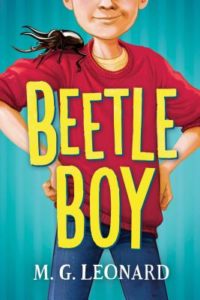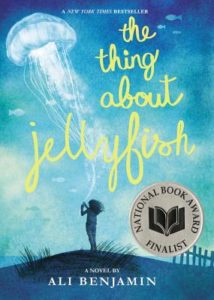craft review by Kat St. Claire
Four books we read in our MG Book Group this year got me thinking about how a writer can use science and science facts to launch into fiction, even the fantastic. I’ve divided these four books into two categories.
The first category I’ll call, From science facts to science fiction with humor.
The books:
- Beetle Boy by M.G. Leonard
- Unidentified Suburban Object by Mike Jung
The second category I’ll label, From science to personal plight resolution
The books:
- See You in the Cosmos by Jack Cheng
- The Thing about Jellyfish by Ali Benjamin
(SPOILER ALERT! This review will give away key surprises in multiple books.)
From Science Facts to Science Fiction (with Humor)
Beetle Boy by M.G. Leonard

In Beetle Boy, Darkus Cuttle’s father was forever telling him to be scientific in his approach to things. “Life is a mystery, son, and science the tool for understanding it.” So, when Darkus finds a large rhinoceros beetle and makes it his pet, he—and the reader—study about the habits of beetles (Coleoptera is the scientific name.), what they eat and how they like their living space, (tea cups for housing, please) and a lot more.
But the science goes sci-fi when Darkus, who is on a quest to find his missing scientist father, discovers that his pet beetle, Baxter, exceeds normal beetle abilities. Baxter understands what Darkus says and even comes to his rescue when he calls. And when Darkus looks into his beetle’s eyes, he feels like the two of them–boy and beetle–are connected somehow, like kindred spirits.
But insects are insects and humans are human, right? Ask villainous geneticist cum fashion designer Lucrecia Cutter. Ask her, too, what kind of legs she is hiding under those long skirts. Human or insect? Leonard moves heavily into the fantastical with Cutter. But Darkus’s journey of discovery is laced with lots of informative science bits and humor enough to keep the creepiness at bay.
Unidentified Suburban Object by Mike Jung
 In Unidentified Suburban Object, genetic testing is the science that launches our heroine, Chloe Cho toward the discovery that she and her family aren’t really Korean aliens living in America, but actual from-outer-space aliens. No amount of online Korean cooking lessons will change that. And the fish her father raises in the backyard greenhouse? Not your usual earth variety, but a species that gives her out-of-this-world family powers beyond earthly human abilities. (Try turning neon when you lick a fish.) All this with ample doses of humor, not so alien to middle grade earthling readers, especially from Chloe, with her sharp wit, who sees the irony in her life: “Today on Survival of the Weirdest…” she quips. “I could totally have my own reality show.”
In Unidentified Suburban Object, genetic testing is the science that launches our heroine, Chloe Cho toward the discovery that she and her family aren’t really Korean aliens living in America, but actual from-outer-space aliens. No amount of online Korean cooking lessons will change that. And the fish her father raises in the backyard greenhouse? Not your usual earth variety, but a species that gives her out-of-this-world family powers beyond earthly human abilities. (Try turning neon when you lick a fish.) All this with ample doses of humor, not so alien to middle grade earthling readers, especially from Chloe, with her sharp wit, who sees the irony in her life: “Today on Survival of the Weirdest…” she quips. “I could totally have my own reality show.”
From science to personal plight resolution
These two science based tales, although they also have good doses of humor, are more deeply psychological in nature. They are really about the personal lives of the main characters. In these stories, science is the vehicle the characters use to navigate the world, their stalwart backing that they lean against as they travel the murky waters of emotional reality to reach the answers to their personal quests.
See You in the Cosmos by Jack Cheng

In See You in the Cosmos, the story is told in a unique way, using eleven-year-old Alex Petroski’s recordings. Alex wants to contact aliens. He’s recording messages for them on his golden iPod, the way his hero, Carl Sagan made recordings of earth sounds on a golden disc. And, like his hero, Alex plans to send his recordings into space. To do that, he’s building a rocket. By himself.
Along the way, he runs into obstacles and into interesting people who try to help him. But his problems aren’t just with his rocket. He has questions about his dead father. And his mother whom he’s been caring for—by himself—needs help. But his older brother in faraway L.A. hasn’t been very helpful. Alex’s fascination with rockets and the people he meets in his quest to launch his iPod into space help him along the way toward personal resolution.
The Thing about Jellyfish by Ali Benjamin

In The Thing About Jellyfish, Suzy Swanson is a facts kind of person. Especially science facts. The story opens with her prescient observation: “A jellyfish, if you watch it long enough, begins to look like a heart beating . . . like a ghost heart, a heart you can see right through. Right into some other world where everything you ever lost has gone to hide.”
Her best friend, Franny, a good swimmer, has died in a swimming accident. Suzy is determined to find out what happened. She decides that it very well could have been from a jellyfish sting. But how can she prove it to grownups who tell her that sometimes things just happen? She plans to find out all the facts she can about jellyfish, then write a report that will make it clear and prove it to them.
But throughout her jellyfish research, we learn about Suzy and the problems she had with Franny before her death. Suzy feels compelled to find answers about her friend’s death to right the wrongs between them.
These four books have four different approaches to infusing a middle grade novel with science. As you approach new and in-progress projects, think about how science can make for a richer story.
Action: Consider how science can inform your work-in-progress.
Action: Write down five story ideas that center on a character obsessed with a particular scientific question. How will science help them solve a personal problem?
Kat St. Claire writes in her downtown Menlo Park treehouse where traffic sounds like ocean waves and imagination reigns. Her fiction and poetry for children have received a number of awards and publications. Kat is currently working on a middle grade novel/series. She is a member of SCBWI, loves the MG Lunch Break book discussion group, and is pleased to be included in the Kidlit Craft blog.
Find her on Facebook at Kat St. Claire-Writer and on her web site, katstclaire.com.


COMMENTs:
0